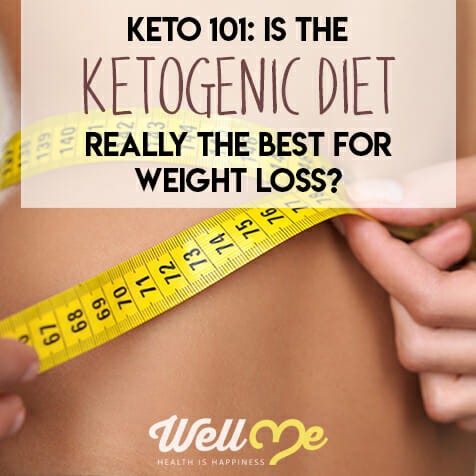Keto 101: The Ketogenic Diet is for Weight Loss?
You will find a million distinct diets out there, all claiming they can help you lose weight fast. Some are grounded in years of traditional science, while others ask that you have a little bit of religion.
One diet that has been around for decades but has recently removed is the ketogenic diet. While it was initially developed in an attempt to assist children suffering from seizures, its other advantages have become quite apparent and they are encouraged by a great deal of scientific study.
If there’s 1 thing which this particular diet claims to do, it is to help you eliminate weight and enhance your health. Continue reading to find out more about the ketogenic diet including what it is, what benefits it provides, and how to trace along.
What Is the Ketogenic Diet?
The ketogenic diet takes high fat, low-carb to the extreme. In fact, the goal is to eliminate carbohydrates as much as possible. That means you’ll be eating foods like grass-fed meat, wild-caught fish, pastured pork and poultry, healthy fats, and leafy green vegetables. At the same time, you’ll be cutting out all grains, lots of fruit, and sugary beverages.
While you may be ditching some foods that you love, this diet is by no means a low-calorie, restrictive nightmare. In fact, many of the foods you’ll be eating everyday are the foods you probably think of as prohibited in a typical diet. If the first thing that crosses your mind when you hear the word diet is, “take away anything but my meat”, this may be just the solution for you.
But how exactly does the ketogenic diet work?
The goal of this diet is to reduce the amount of glucose you consume. When you eat foods with sugar and carbohydrates, your body breaks them down into glucose which causes your blood sugar to rise. In response to this rise in blood sugar, your pancreas releases insulin, a hormone that enables your cells to absorb glucose from your bloodstream and to burn it for energy.
By reducing your carb intake, you reduce your glucose levels as well as your insulin production. In the absence of glucose, your body will be forced to start burning something else for fuel – fat. When your body begins burning fat for energy instead of carbs, you enter a state of ketosis. This is where the ketogenic diet gets its name!
If all of this sounds great, it is because there really are some positive effects to this diet. While it may seem obvious that burning fat for energy is a great way to lose weight, there really are several important benefits to this diet that are worth considering.
Benefits of the Ketogenic Diet
There is a reason that the ketogenic diet is taking off in popularity. With many dieters reporting fast and significant weight loss while researchers are beginning to see that there is scientific merit to the process, it has a lot to offer anybody that is interested in losing weight quickly. However, there is more to the diet than just weight loss.
It Won’t Leave You Hungry
As you can probably imagine, a diet that results in your body burning fat for energy can result in rapid weight loss[1]. Unlike many other diets, however, you won’t have to starve yourself to see the pounds fall off. In fact, thanks to the filling nature of the high-fat foods that are the staple of this diet, you shouldn’t struggle with hunger at all!
On top of those meaty, filling foods, there will be a chemical effect that should also help you feel satisfied after meals. By reducing insulin production, you’ll be shutting off ghrelin, the hormone responsible for triggering your appetite[2].
There Are Plenty of Keto-Friendly Food Options
In this sense, a ketogenic diet can take away much of the stress that people associate with healthy eating. It can be truly difficult to cut out so many foods that you love, not to mention the discouraging effect that constantly feeling hungry can have on a person’s will to keep up the effort. By allowing you to enjoy many of your favorite foods and by supporting feelings of satisfaction rather than hunger, the ketogenic diet can keep you on track to lose weight.
It Can Lower Your Risk of Diabetes
While the primary benefit of a ketogenic diet that people gush over is the rapid weight loss, it actually has plenty of long-term benefits as well.There is research that suggests that a kotegenic diet will lower glucose intake, which in turn should lower your risk of diabetes[3].
It May Be Good for Your Mental Health
Along with weight loss, ketosis can be beneficial to your mind and attitude. Many people report feeling a boost in cognitive function and attentiveness upon entering ketosis. While there is not a deep bevy of scientific research supporting these stories from people enjoying success on the diet, it was initially developed in an attempt to aid children suffering from epilepsy, so it would seem that there is some reason to believe there could be a connection to cognitive health. Essentially, this is a diet that should leave you feeling great while you lose weight.
Are There Any Downsides to the Ketogenic Diet?
While being in ketosis should leave you feeling great, getting into it may not be as enjoyable. The transition from burning glucose for energy to burning fat for fuel can take several days, days during which you may experience headaches, fatigue, difficulty sleeping, and lack of focus.
For some people, this stage of the diet may be easier to persevere through than for others. However, getting started isn’t the only hurdle you will encounter.
In addition to experiencing some withdrawal effects when transitioning into a state of ketosis, there are some challenges associated with maintaining a ketogenic diet. For example, significantly reducing your glucose intake may put you at risk for burning through muscle rather than fat. The best way to counteract this is to eat plenty of protein and to be smart about how you exercise.
Some people experience fatigue even when in ketosis, which can reduce interest in getting to the gym. While fatigue does occasionally occur, the positive mental and physical aspects the result from entering ketosis generally overshadow this effect more often than not, leading to an overall positive experience. .
While on a ketogenic diet, you also risk increasing cortisol levels (the stress hormone), and women may experience negative effects to their hormone balance. It is already recommended that people on a ketogenic diet engage in light exercise such as yoga and short walks as a method for keeping active and for stabilizing blood sugar levels. Plus, both of these activities are known to lower stress and benefit mental health.
The final potential downside to this diet has very little to do with the diet at all. It is simply a diet that requires diligence, as veering off-course can result in falling out of ketosis, which mitigates any positive effects you may be working towards. However, the reality is that all diets involve diligence and personal responsibility. By committing yourself to this diet, you can experience impressive results at a rapid speed, making it well worth the commitment.
How Does the Ketogenic Diet Compare?
In order to decide whether the ketogenic diet is right for you, it is important to understand what other options are out there and the ketogenic diet compares.
Two similar options that are particularly popular are low-fat diets and Mediterranean diets.
1. Low Fat Diets
Low-fat diets, as you may be able to guess from the name, tend to cut out unhealthy fats. By ditching unhealthy foods that are full of fats, you’ll be able to kick some weight simply by consuming less of the things that are causing you to gain it. Instead, you’ll want to load up on low-fat foods.
The problem is that many “low-fat” foods are loaded up with artificial sweeteners and other unnatural methods to make them as tasty as their fattening counterparts. This can often result in a diet that is no healthier for you than what you were following beforehand. You will have to monitor nutrition labels and ingredient lists carefully in order to make sure you are buying foods that will actually keep you healthier.
Additionally, it is important to make sure that you are getting the fats that you need. While some fats do you no good, foods like avocados and peanut butter will be essential to make sure you are maintaining a balanced diet if you do decide to kick fatty foods to the curb.
2. Mediterranean Diet
The Mediterranean diet is one of the oldest out there. Scientists and researchers noticed the relative health of people living in the Mediterranean region and began to attribute this phenomenon to what they have been eating. The diet has an emphasis on fruits and vegetables along with poultry and seafood. Additionally, snacks take the form of things like nuts and grapes instead of chips and cookies.
There are many benefits to this diet. It is quite sustainable and simple to follow because of the wide variety of foods that apply. While you will want to limit your intake of red meat, you will be able to indulge in a wide variety of fruits, vegetables, and whole grains, along with other healthy options.
The downside of this diet is simply that it won’t do the work for you and, as is the case with most diets, it requires portion control. You will want to engage in an active lifestyle in order to make the most of the healthy foods in this diet, or else you won’t be getting the most out of it and weight loss could be less noticeable.
3. The Paleo Diet
The Paleo diet is another low-carb diet built around the simple idea of getting back to your ancestral roots with what you eat. That means you don’t eat anything that a caveman wouldn’t. Interestingly, the objective of a Paleo diet is not to lose weight, but to improve health. The big question is what this really means when it comes to planning things out.
For starters, the Paleo diet requires the elimination of grains and dairy. That means no bread or pasta. This leaves plenty of meat, fish, eggs, fruits, vegetables, oils, and nuts. It is similar to the ketogenic diet, but does not rely on entering ketosis in order to lose weight. Instead, the goal is to simply improve your diet and, in doing so, your health.
One of the mistakes many people make when trying out the Paleo diet is eating a whole lot of meat and not much else. While it may seem great to fry up some bacon every morning and say it is part of your diet, this is not the way to get results. Instead, maintaining balanced portions and getting plenty of fruits and vegetables will be as essential to this diet as cutting out the bad carbs. When Paleo dieters have been able to do that, many have touted the diet as a key to their health.
4. The Atkins Diet
The Atkins diet has noticeable similarities to the Paleo diet because it shares many of the same allowed foods, but the intention of the Atkins diet is to lose weight, while the Paleo diet is intended to support health. However, there are several other notable differences.
The Atkins diet is less concerned with the quality of the foods being eaten and more concerned with the ratio of proteins, fats, and carbs. This is referred to as the macronutrient ratio. The Atkins diet also allows for the consumption of processed foods so long as they are low carb and do not affect weight loss.
The primary difficulty of the Atkins diet is simply maintaining it, as dieters are required to meticulously count calories. Part of the nature of this diet is that it attempts to bring the body into ketosis while allowing for some foods that the ketogenic diet does not, making more careful monitoring of consumption important to success. Dieters that are able to sustain proper food consumption do herald Atkins as a diet that allows for significant weight loss.
5. The Ketogenic Diet
While all diets have their pros and cons, the ketogenic diet stands out as being unique. None of these options is objectively better than the others. Instead, it is about finding the diet that suits you. The ketogenic diet comes with two significant benefits when compared to other diets.
The first benefit is simply that you get to eat red meat. While it will be important for you to be mindful of your portions, this should leave you relatively full compared to other diets while allowing you to hold on to many foods you love that other diets don’t have very much room for. You will want to balance out the red meats with fish, poultry, and vegetables, but you will still get to have your steak.
The second benefit is that the ketogenic diet is able to help you lose weight without significant amounts of activity. Because it achieves its goal through shifting the processes your body uses to create energy, it is a diet that will do a lot of the heavy lifting for you once you are able to get into it.
A diet that allows you to enjoy plenty of meat while losing weight? It sounds too good to be true, which is why it is important to understand some of the challenges that come with a ketogenic diet.
The first challenge of this diet is that cutout out carbs may cause you to experience symptoms of withdrawal – symptoms like headache, fatigue, and irritability. It can also be challenging to accurately calculate and track your macronutrient intake while following the diet. Fortunately, there are plenty of free recipes and meal plans out there to help you stick to the diet.
Tips for Following the Ketogenic Diet
Like all things, there are ways to go about a ketogenic diet that will make things easier and more effective for you. By following a few pieces of advice, you should be able to have a vastly improved experience with your ketogenic diet.
Hydrate
This is an important habit to get into if you are not already drinking plenty of water. Drinking enough water will support your overall health and make the transition to ketosis easier by reducing some of the withdrawal symptoms.
Make Sure to Get Enough Sodium
As mentioned earlier, following a ketogenic diet will reduce insulin production. One downside of this is that your kidneys will excrete more sodium. You can counteract this effect simply by consuming a few additional grams of sodium every day – just make sure it comes from natural sources, not table salt! There are plenty of natural options out there for you, including celery, sprouted seeds, and kelp.
Keep Your Bowel Functioning Properly
One side effect that some people experience when on a ketogenic diet is constipation. This can be easily remedied by drinking enough water, getting sufficient electrolytes, and eating more vegetables.
Exercise
While you may feel a bit fatigued early on in your ketogenic diet, you will benefit from regularly engaging in light workouts. If you can commit 20-30 minutes to light exercise five days a week, you will have a much easier time staying in ketosis. Exercises like yoga, elliptical exercises, and short walks will help to balance your blood sugar levels, which will keep you in ketosis.
Get Plenty of Sleep
Getting good sleep every night will help to lower stress hormones, which will in turn make it easier for you to stay in ketosis. This will also have a positive effect on your experiences with fatigue as you are entering ketosis. By getting 7 to 9 hours of uninterrupted sleep (that means no blue lights), you will find yourself with more energy and better results in your ketogenic diet.
Summary: Why the Ketogenic Diet?
If you are looking for a diet that lets you hold on to the foods you love while losing weight quickly, the ketogenic diet may be right for you. You will have to commit yourself to it fully in order to receive its benefits, but if you are able to adhere to it dutifully, you will be able to lose weight in no time.
If this sounds like the diet for you, the next step is simply putting in the work. It is important to know exactly which foods are okay and which you should toss out before beginning on this diet, as it requires diligence. However, there are plenty of resources out there that can help you to know exactly what you need. Once you know what you will be eating, it is as simple as sitting down at the dinner table!
Action Steps: How to Prepare for Your Ketogenic Diet
- Make a list of all the foods that you can eat on the ketogenic diet. The ketogenic diet is known for allowing dieters to eat plenty of the food that they love, but it is important to understand exactly what that entails. By making a list and sticking to it, you ensure that you won’t accidentally let anything you can’t eat sneak into your diet.
- Plan out your meals. You will want to know exactly what you are going to eat everyday and when you are going to eat it so that you can know ahead of time whether you are on track to enter ketosis. If you improvise too often, you may find yourself off track without a clear path besides starting over. Save yourself that trouble by simply making a plan.
- Check the plan using a website such as freedieting.com, which will allow you to set up the proper amount of calories and macronutrient percentages. You will be aiming to make 70-80% of your diet fats, 20-25% protein, and 5-10% carbs. By knowing these percentages and making sure that your plan will allow you to meet these goals, you are setting yourself up for success.
- As you begin the diet, monitor yourself to make sure that you are on track. Different people have different optimal diets for entering ketosis, so it will be important that you understand which direction you are heading in as you feel your way through the early stages of the diet. The easiest way to monitor your progress is to use urine testing strips, which will tell you where you are on your journey to ketosis.
The most important part of a ketogenic diet is simply having a plan and sticking to it. By keeping yourself organized and diligent, you set yourself up to experience success and entering ketosis. Once you are there, you should see the results pile up (and the pounds fall off) faster than on any diet you’ve been on before.


















